Decimals intimidate many students (and adults)! It’s important to overcome that intimidation to be able to help teach multiplying and dividing decimals. This article will look at the difficulties many students have when it comes to the multiplication and division of decimals and how to overcome those challenges.

Barriers When Kids Learn Multiplying and Dividing with Decimals
Require a Level of Abstract Thinking
Using algorithms with multiplying and dividing decimals requires students to claim a level of abstract thinking about numbers that they may not yet be ready for. If students have not yet had enough experience with decimals as a concept or with modeling decimals, we will often see students struggle with this concept.
If you realize that students need foundational understandings of decimal concepts, check out my blog post about decimal place value.
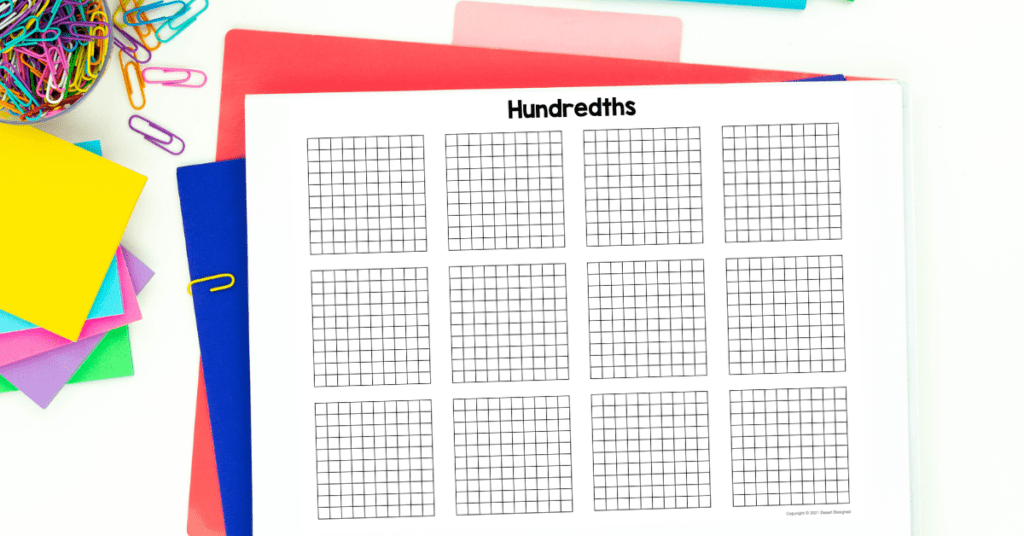
Decimal Points Freak Kids Out
Students who are new to interacting with decimal points often aren’t sure how to deal with them in numbers. They may struggle with the concept of “less than one, but not negative.” Interacting with real-world examples of decimals can help with this.
Foundational Understanding Associated with Multiplying and Dividing is Lacking
In addition to needing a basic level of decimal place value understanding, students also need to be comfortable with the concept of multiplication and division. They must be able to recognize the grouping concepts associated with both multiplication and division and have a solid familiarity with their basic math facts. When these foundational skills are missing, students have a lot to overcome when learning to multiply and divide decimals.
Imagine Your Students Multiplying and Dividing Decimals with Ease
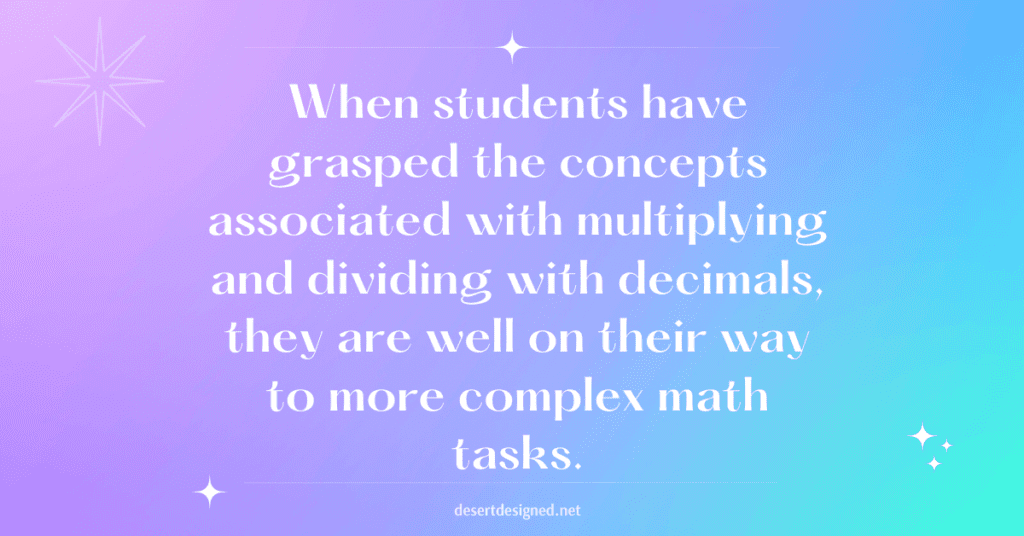
When students have grasped the concepts associated with multiplying and dividing with decimals, they are well on their way to more complex math tasks. Now, you just need to figure out how to help your students get there. Next, I will guide you through various strategies you can use when teaching kids this essential multiplication and division skill.
Move Towards Understanding of Multiplying and Dividing With Decimals
The understanding of multiplying and dividing with decimals will not come to students overnight or without some methodical teaching processes. Here is how you can get them where they need to be.
Diagnose the Problem
If you have tried teaching this skill, you want to start by examining where the skill is breaking down for kids. Here is a list of questions to ask yourself before moving on:
- Do Students understand what multiplication and division are all about? (Think: grouping, groups of, equal segments)
- Do students know their basic math facts? (particularly multiplication facts)
- Have students grasped place value foundational concepts? (Can they identify decimals to the hundredths place in a model? Do they understand equivalent decimals and annexing zeros to the end of a decimal?)
- Have students mastered the multiplication and division of whole numbers?
- Are students able to identify the operation needed in multiplication or division word problems?
By thinking through the answer to the questions above, you will know if your students are ready to tackle multiplication and division with decimals or need foundational work or review before teaching this skill.
Begin with Models
Assuming that students are ready for multiplying and dividing decimals, I recommend that you begin by using concrete models for this process. You can check out my blog post about multiplying decimals using models here.
When guiding students through working with models, it is easiest to multiply or divide a decimal by a whole number. Your whole number represents the number of groups in this case. So, if you are multiplying 0.2 by 3, we have three groups of two tenths. If you are dividing 0.15 by three, you will be splitting fifteen hundredths into three equal groups.
Make your life easier and ease students into the skill by using numbers that are compatible and easy to model. Remember, as you are just introducing the skill to your students, they are likely just trying to master the basics. If it seems easy to them at this point, that is a great thing! They will have better attitudes and confidence going into the skill as the processes become more challenging!
Here are a few tips to remember as you introduce the initial concepts of multiplying and dividing with decimals:
- Keep problems simple – we are not trying to trick kids at this point. We WANT them to understand what is happening
- Bring in word problems frequently – while some people (adults and kids alike) are intimidated by word problems, when we are working with decimals, they can help the math take on more meaning and be more accessible.
- Make problems that are grounded in basic math facts. Do not require complex multiplication or long-division at this point. Our goal here is an initial understanding of the math that is happening. By keeping your sample problems focused on math facts students already know, you will help them focus on the skill of using the decimals rather than struggling to do complex calculations.
Using Anchor Charts to Provide Samples
I love putting up anchor charts to provide a visual sample to students for math concepts. Check out these anchor charts for multiplying and dividing decimals. If you would like access to the oversized decimal models I used to create these charts, sign up for my email list today and get access to this great free tool of decimal place value printable models!
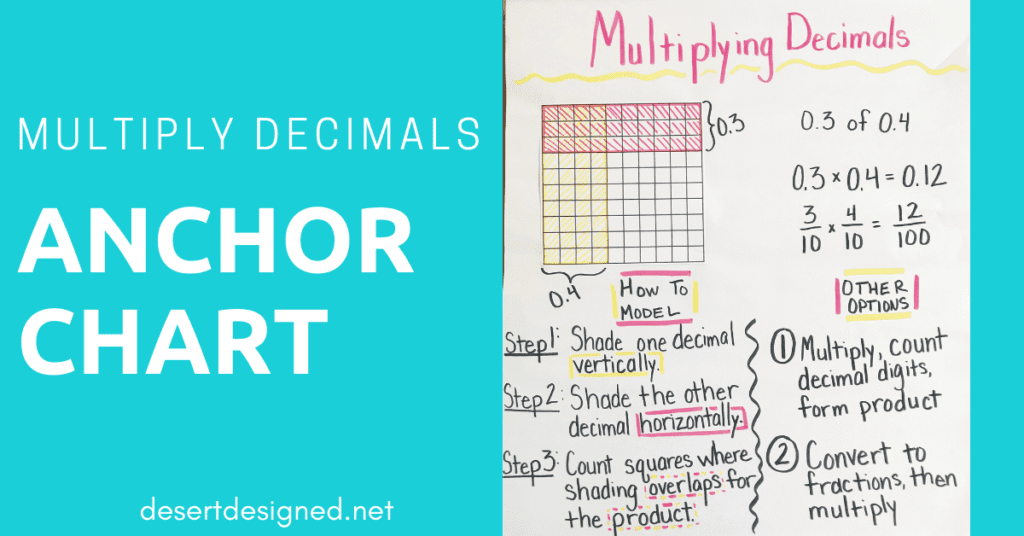

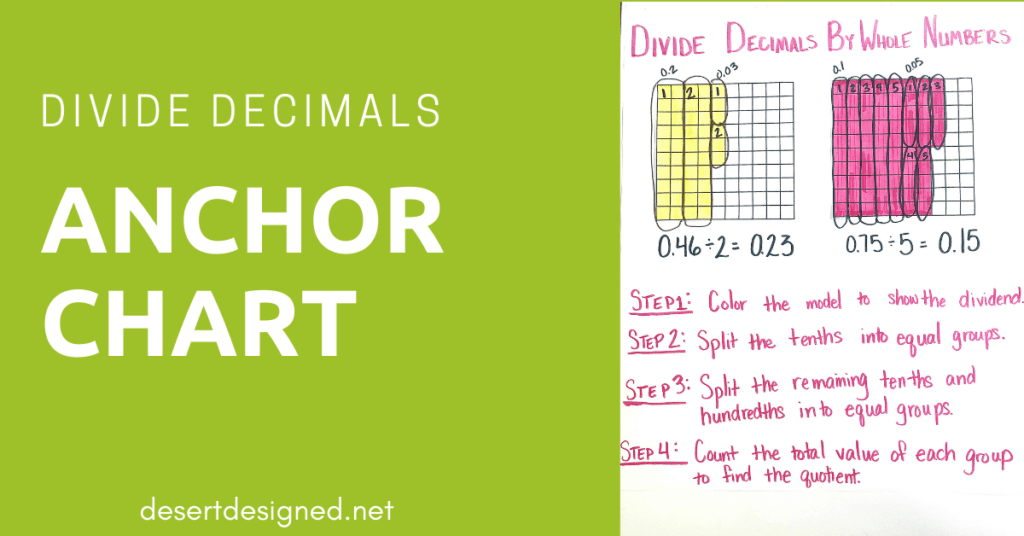
Connect Models to Algorithm
Once students are showing speed and accuracy with the models, it is time to start writing down the math problem shown. As students record the problem and solution, they will begin to see patterns in the calculations and the placement of the decimal point in the answer. By repeatedly recording their work as they practice multiplying and dividing with decimals, they will begin to feel less and less dependent on the models and will often request to “just do the math.”
Focus on the Algorithm
After students are less reliant on the models, you will see them ready to isolate the algorithm to solve the multiplication and division with decimals problems. It is at this point that you will want to begin to introduce problems that require more calculation. Slowly ease students into more complex problems and continue to reinforce what students have already learned. At this point, many students struggle with where to put the decimal point in the answer.
Whenever my students are showing difficulty with where to place the decimal point in the answer, I bring them back to the more simplistic problems and help them connect the decimal point placement in those problems with whatever problem they are now doing.
Continue to Practice Multiplying and Dividing with Decimals
Students need to get plenty of practice with multiplying and dividing with decimals to master the skill. I love assigning these Boom Cards to my class to help them get the practice they need.
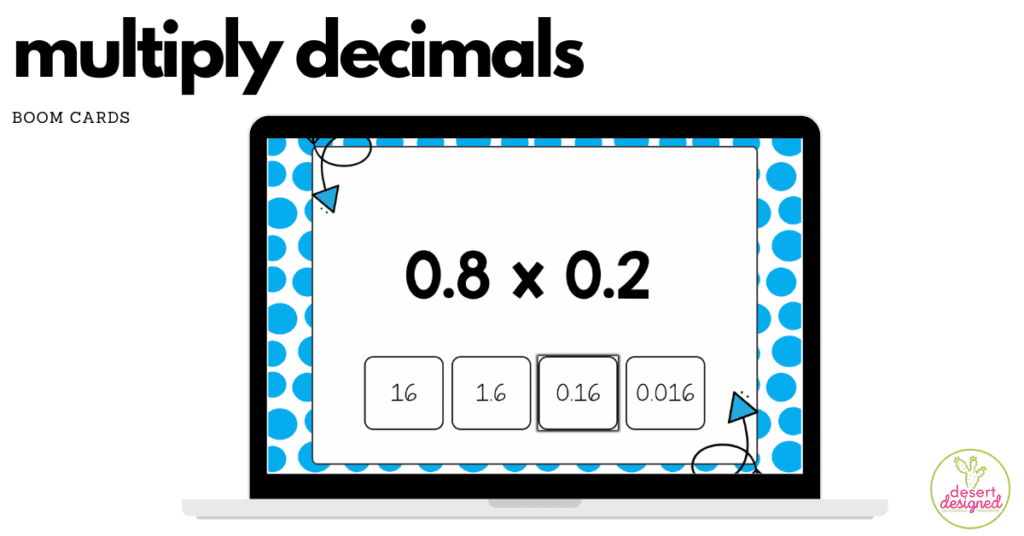
Decimal Place Value Models for Anchor Charts

Create anchor charts for your classroom using these decimal place value models to demonstrate multiplication and division concepts with decimals. Sign up for my email list to get your copy today.



